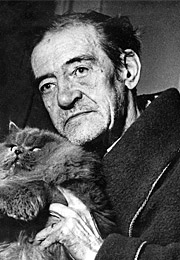Utrillo is best known for atmospheric street scenes of Paris rendered in a broadly geometric style. He grew up in Montmartre, where he lived a bohemian lifestyle. His mother was the painter Suzanne Valadon, who had worked as a model for many artists, including Pierre-Auguste Renoir, Henri de Toulouse-Lautrec, and Puvis de Chavannes. At the age of eight, a Spanish painter named Miguel Utrillo y Morlius claimed paternity, but Utrillo’s biological father remains unknown. He was raised by his grandmother and did not show any interest in becoming an artist in his youth; in his late teens, his mother urged him to take up art to combat his dependency on alcohol. He began to paint landscapes around the village of Montmagny, north of Paris, with thickly impastoed paint. His focus on everyday life and predilection for the materiality of paint was in part inspired by artists such as Gustave Courbet and Camille Pissarro. Utrillo then returned to Montmartre, whose streets, churches, shops, and houses would become the major subject of his painting throughout the rest of his life, often presented with a sense of flattened, orderly space and brusque strokes of paint.
Some of Utrillo’s most famous paintings, from around 1909–14, are picturesque yet austere compositions dominated by tonalities of white, which he created by mixing paint with glue, plaster, or even cement. As his health deteriorated, he was no longer able to paint the streets of Paris from direct observation, instead relying on postcards viewed in the studio; his palette became increasingly dark. Despite his difficulties, Utrillo remained prolific, and his reputation increased among collectors and the public from the 1920s onward.



